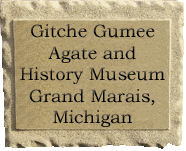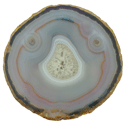MINERAL OF THE MONTH
December 2017 - Septarian Nodule
Septarian nodules are round concretions found in sedimentary rocks. Concretions are hard solid masses formed by the accumulation of matter within sediment. Although scientists do not agree on the details and specifics of their formation, there are several theories. One proposal suggests they formed when there was dehydration and shrinkage of clay, gel, or organic cores within sedimentary pockets. Others believe there was an expansion of gases produced by the decay of organic matter that fractured material within sedimentary pockets. One more theory is that an earthquake, compaction, or other geologic forces fractured material within sedimentary pockets. However the sedimentary material fractured, mineral-rich fluids filled in the spaces between the fractures allowing calcite, siderite, pyrite, and other minerals to crystalize and fill in the open areas within the cavity.
The most well-known septarian nodules are found in Utah. The Utah septarians developed during the Cretaceous period between 50 and 70 million years ago. At this time the Gulf of Mexico had expanded northwest into the area that is now southern Utah. Scientists believe that volcanic eruptions killed marine organisms, causing them to sink to the bottom of the shallow sea. The decomposing material chemically attracted sediments causing the mixture to form into mud balls. When the ocean receded, the mud balls dried out causing the interior sections to crack and shrink. Over time, mineral-rich solutions infiltrated the cracks causing crystals to form and fill in the cracks. Septarian nodules, sometimes called lightning stones, can also found on the Lake Michigan shoreline as well as in New Zealand, England, Morocco, and Madagascar.
Septarians are composed of calcite (the yellow centers), aragonite (the brown lines), and limestone (the outer grey surface). Occasionally, fossils can be seen within or on the surface of the nodules.
CITES
- https://en.wikipedia.org/wiki/Concretion
- Tony Hisgett, https://commons.wikimedia.org/wiki/File:Calcite_septarian_nodule_ROM.jpg
- Sven Teschke, https://commons.wikimedia.org/wiki/File:Septarie_by_Steschke.JPG
- Keith Pomakis, https://commons.wikimedia.org/wiki/File:Septarian_Nodule.jpg
- http://www.therockshed.com/information.html
Mineral of the Month Archives
May 2007: Rainbow Fluorite
June 2007: Lake Superior Michipicoten Agate
July 2007: Labadorite
August 2007: Rain Flower Agate
Fall 2007: Malachite
December 2007: Nepheline Syenite
January 2008: Native Copper
February 2008: Amazonite
March 2008: Lake Superior Agate
April 2008: Shadow Agate
May 2008: Apohpylite
June 2008: Ocean Jasper
Summer 2008: Marra Mamba Tiger's Eye
September 2008: Mohawkite
October 2008: Mexican opal
November 2008: Prehnite
December 2008: Picture Jasper
January 2009: Sea Shell Jasper
February 2009: Polychrome Jasper
March 2009: Selenite Desert Rose
Spring 2009: Coyamito Agate
July 2009: Obsidian Needles
August 2009: Goethite
September 2009: Banded Iron Formation
Fall 2009: Fairburn Agate
March 2010: Fossilized Dinosaur Bone
April/May: 2010 Kentucky Agate
June 2010: Nantan Meteorite
July 2010: Mookaite Jasper
Aug/Sept 2010: Polyhedroid Agate
Fall 2010: Ammonite Fossil
September 2011: Petoskey Stones
Spring 2011: Petrfied Wood
Winter 2011: Argentina Condor Agate
January 2012: Mary Ellen Jasper
March 2012: Mexican Crazy Lace Agate
June 2012: Moqui Marbles
September 2012: Chlorastrolite Greenstone
March 2013: Jacobsville Sandstone
August 2013: Unakite
November 2013: Skip-an-Atom Agate
April 2014: Tiger's Eye
September 2014: Black Corundum
February 2015: Condor Agate
June 2015: Petoskey Stone
November 2015: Slag
June 2016: Lake Superior Copper Replacement Agates
March 2017: Chert
July 2017: Kona Dolomite
Copyright All rights reserved.
Gitche Gumee Museum.
E21739 Brazel Street
Grand Marais, Michigan 49839










